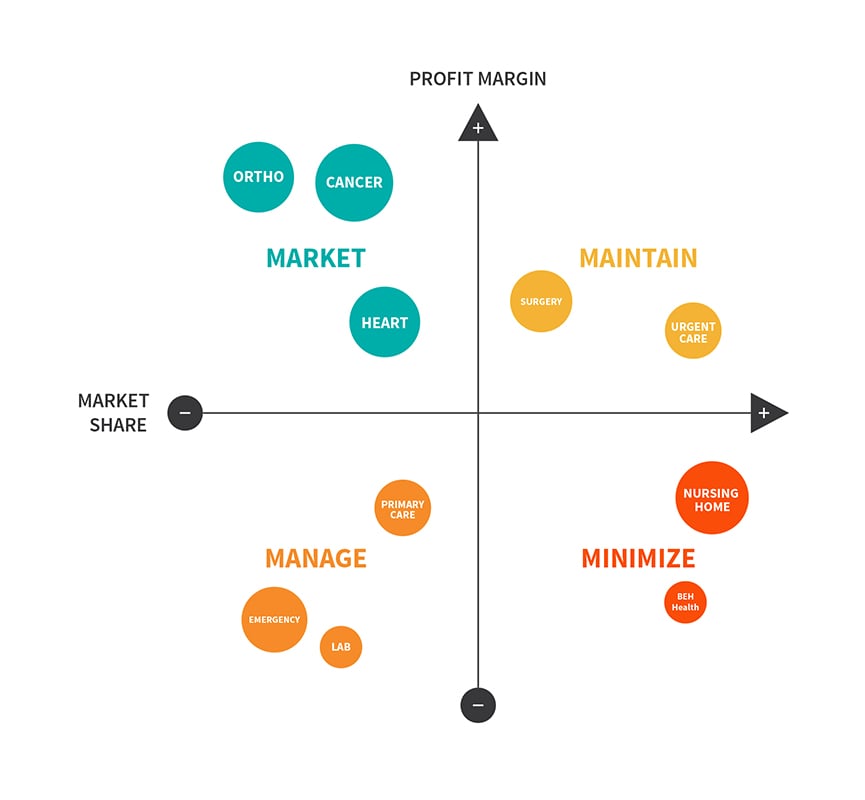How to Prioritize Your Service Line Marketing Strategies

Regardless of the size of your organization, prioritizing which service line gets attention and marketing resources is a common problem. Each department/service line director has their own goals to achieve, and they are relying on you and your team to create solutions to the challenges preventing them from moving forward. Based on our decades of experience in the health system marketing space, we find that the best tool for deciding what services, procedures, new technologies, and providers should receive a chunk of your time and resources is portfolio mapping.
Use Portfolio Mapping to Prioritize Service Line Marketing
Integrated strategic planning may be intermittent within your organization and when those meetings do take place, marketing decisions are typically made around individual service lines without a lot of data to back it up or thought on how to integrate marketing into a master strategy. They say the squeaky wheel gets the grease, and while there’s a time and a place for that sort of attention, it’s your role to analyze your organization’s priorities and keep everyone in the loop so you can stay on track (and not lose your mind in the process!).
Setting these priorities can be incredibly challenging. The constant churn of inquiries across departments won’t stop overnight—you’re probably fielding 100 or more daily emails with new requests, and follow-ups to existing requests and the last thing you want to tell the service line director is that they’re not part of the priority bucket. You must base your “no” on logic so that when someone brings you a request you need to decline, they have a greater understanding of why you can't fulfill their request and you have a greater justification for your decision.
For more tips on service line marketing success, check out 20 Questions to Ask Your Service Line Leaders and three tips to Boost Your Service Line Marketing Success.
What is portfolio mapping?
Portfolio mapping is a strategic management tool. It's a way to visualize the areas in your business that are currently performing well, what’s actually driving dollars for your organization, which areas need assistance, and those that could perform well without much effort from marketing.
Prioritization is more than just ranking your service lines. It is about purposefully choosing what to do—and as importantly—choosing what not to do. Priorities must be aligned with your organization’s key strategies and anchored by solid facts. This isn't the place for internal politics or popularity contests.
Step 1: Find key business metrics for each major service line.
The first step in portfolio mapping consists of finding and recording key business facts for each of your core services or service lines. You can do this by evaluating the previous year’s revenue and the current year’s projection for each area. If you don’t have this information easily accessible, your finance department holds the key. Reach out to see what information/resources they can provide for each service line. It’s more about comparing your service lines than trying to determine the perfect metric. When researching the services within your organization, some good metrics to consider are market share, profit margin, revenue, and capacity.
Step 2: Place service lines in a bubble chart to make a map.
An ideal approach to cataloging the identified business information is to create a bubble chart broken into four quadrants. The x-axis will represent market share and the y-axis will represent profit. By leveraging the information gathered in step one, use the data to chart each service line to your portfolio map. Let the size of each bubble represent the size of the revenue brought in by that service line.

What goes where?
This is a lot like a financial portfolio—but for you, it’s a way to look at your business units more strategically, mapping where you’d like your bubbles to grow.
The “market” quadrant is where your market share is low, and your profit is high—this is the ideal place to spend your resources.
The "maintain" quadrant, where you have a high market share and high profits, is still a good place to market, but it takes more resources to drive increased market share.
In the “manage” quadrant, there is a low market share, and it is not a profitable service. Services that fall in this quadrant require careful assessment. Is it losing money due to unfilled capacity? If so, look at marketing the service. Is it losing money for other reasons? If so, assess the effect marketing can have on the current roadblock or issue.
The “minimize” quadrant contains service areas where you have a high market share, but the service loses money. Generally, this is an area where you do not want to invest your marketing resources.
Click here for our Quick Guide to Service Line Portfolio Mapping.
Step 3: Use the portfolio map to guide budget planning.
The portfolio mapping tool can help you do a deep dive into establishing your budget and develop recommendations with supporting documentation for the prioritization plan, including the marketing investment and scope of marketing services for each service line. Whether it’s your responsibility to set each department’s budget or you have a preset breakdown from leadership, it’s just important to organize your thoughts around the allocated budgets and heavily weigh them. This will build a case for you in the year to come to work with leadership to make better budget decisions.
Establish This Plan, and Stick to It!
Marketing operates just like any other department within your organization: you have a budget and must utilize your staff's time efficiently to get the biggest ROI. Your resources are limited, and this plan will streamline and identify the areas that have the greatest need for valuable time and money.
Evaluate and share your findings annually to help underline your work for the previous year and to set your team up for success in the year ahead. (Dig into the details of successfully executing your strategic plan with our 10% Secret to Healthcare Marketing Plan Success.)
Ten Adams helps our clients analyze their priorities and stay on track toward meeting their strategic goals. If you’re struggling with prioritizing or planning, we’re here to help! Contact Us.
Get Updates
Featured Articles
Categories
- Digital Marketing in Healthcare (14)
- Healthcare Awareness (10)
- Healthcare Branding (13)
- Healthcare Communications (2)
- Healthcare Marketing (2)
- Healthcare Marketing Analytics (1)
- Healthcare Marketing ROI (1)
- Healthcare Marketing Strategy (17)
- Healthcare Recruitment (4)
- Healthcare SEO and GEO (1)
- Healthcare Websites (1)
- Hospital Marketing (20)
- Optimize (1)
- Physician Referrals (1)
- Service Line Marketing (2)

